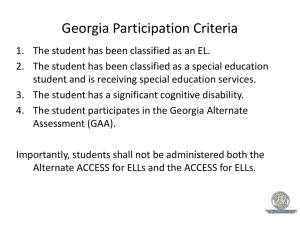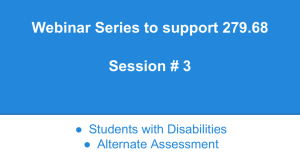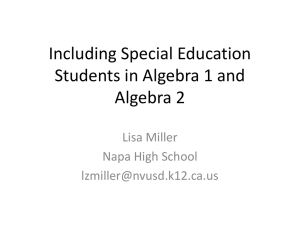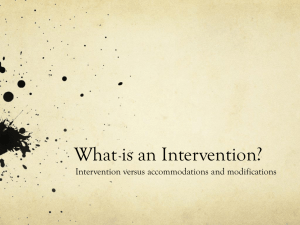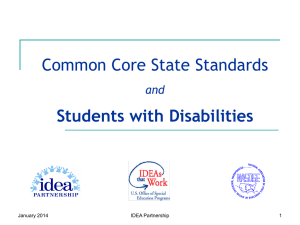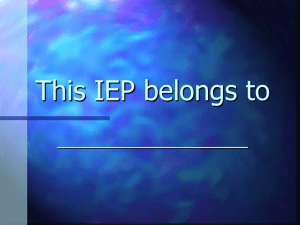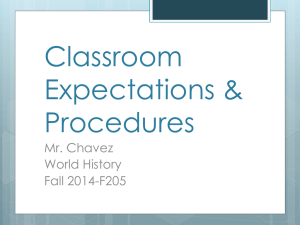NCLB: Accommodations and Alternative Assessments
advertisement
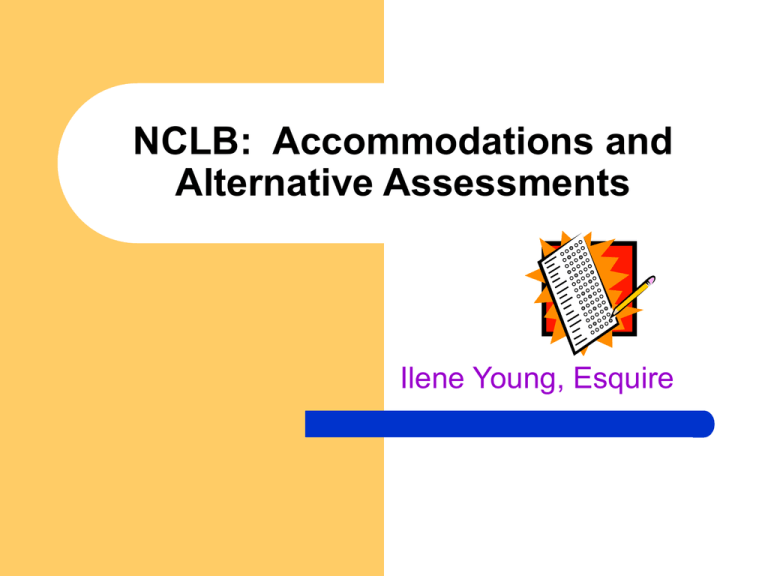
NCLB: Accommodations and Alternative Assessments Ilene Young, Esquire Standards based school reform Prior to NCLB, PA already started standardsbased school reform. Modified to meet NCLB requirements Pa state plan is found at PDE web site www.pde.state.pa.us Creates interlocking laws – Each state must develop & implement an official NCLB plan Reviewed – by US DOE Each public school and district must develop a plan Reviewed by State DOE AYP: Adequate Yearly Progress States must use standardized tests to measure AYP AYP: must meet fixed targets or significantly increase number of students passing. – – In most cases, increase of 10% per year required All students must have passing score by close of 2113-14 sy I Academic Content Standards State required to adopt content standards – – – Math Reading Science Section 6311(b)(1) Public schools must follow the statewide standards.22 PA CODE section 4.4(a) Requirements Standardized high quality assessments All students to be assessed at grade level standards across groups Reporting Consequences 12 year plan After 1st yr After 2nd year After 3rd year After 4th & 5th After 6th year warning Improvement I Improvement II Corrective action I & II Restructuring Assessment Requirements The Title I regulations at 34 C.F.R. §200.2(b)(2) require that a State’s assessment system be “designed to be valid and accessible for use by the widest possible range of students, including students with disabilities and students with limited English proficiency.” Assessment Testing is required to be aligned with academic standards in math, reading and science In PA the main test is the PSSA. Students with significant cognitive disabilities take the PASA. Pennsylvania Alternate System of Assessment. Pa academic standards 22 PA Code Chapter 4 Requirements High technical quality requirements set forth in Sec. 200.2(b) and 200.3(a)(1) including validity, reliability, accessibility, objectivity, and consistency with nationally recognized professional and technical standards Aligning Curriculum and Testing IN PA: The state has also published nonregulatory Assessment Anchors, identifying the most important academic standards tested on state assessments. – Detailing teaching to the test – http://www.pde.state.pa.us (click Pre K-12 Schools, Assessment, and Assessment Anchors) Assessment results Of students in the school for a full year Used to calculate AYP for school Used to calculate AYP for the district Used to calculate AYP for the state Consequences for non-attainment of goals NCLB and IDEA All students, including children in special education, must take assessments – 20 USC section 5311(b)(3)(C) and 1412(a)(16) Must be the same for all students in each grade unless – Accommodations or alternative provided in IEP through regular IEP process Reporting Assessment results for each student must be reported to – – – Parents Teachers Administrators State must issue report Appropriate Accommodations IEP based – – ER based PLEP based Not such as would invalidate test instrument Not within list of forbidden accommodations Title I requires states to provide IEP teams with guidelines for accommodations, and alternate assessments and achievement standards. Accommodations Guidelines States are required to have clear guidelines Invalid accommodations consequences – – Student is considered a non-participant, or; Score is counted as below-basic PA accommodations guidelines at PDE website Types of Accommodations Changes in test environment – – – – – – – Time Place Grouping Special Arrangements Typewriter/keyboard Dictionaries/Reference – several forbidden Special paper,lines,templates, window frames Types of Accommodations Adapted Test Forms – – – Audiotapes of directions Student marks in test booklet adaptations Highlighters Types of Accommodations Other – Reading aloud – – – Only directions w/ no definitions on reading assessment Marking answer book for student Visual cues Simplifying directions Disallowed Accommodations Helping students to answer items – – Eliminating some multiple choice Pointing or highlighting Providing extra time where it invalidates test Allowing accommodations prohibited Failing to maintain test security Testing Accommodations and IEP process Accommodations are to the same as are used to make student successful in classroom Query effect of greater accommodations for PSSAs vs. class work Alternate Assessment What is an alternate assessment? Under NCLB, an assessment designed for the small number of students with disabilities who are unable to participate in the regular grade-level State assessment, even with appropriate accommodations. Defined by characteristic of student, not test. Alternative Assessment can measure progress based on alternate achievement standards can also measure proficiency based on grade-level achievement standards. a State may employ more than one alternate assessment. Alternative Achievement Standard An alternate achievement standard sets an expectation of performance that differs in complexity from a grade-level achievement standard. Requirements Must be – – – aligned with State’s academic content standards Promote access to the general curriculum Reflect professional judgment of the highest achievement standards possible (34 C.F.R. sec 200.1(d)) Query How does this “Cadillac” language reconcile with IDEA “floor of opportunity” Alternate Achievement Standard State is not required to develop Title I requires State to adopt challenging student achievement standards Apply same standards to all schools and children in the state Does not require alternate achievement standards Alternate Achievement Standard A state may set more than one alternate achievement standard Pennsylvania’s system of alternate assessment is the PASA system State must employ commonly accepted professional judgment to define standards Alternate Achievement State must document relationship among the alternate achievement standards Part of the coherent overall assessment plan 1.0 cap on all proficient scores Who is tested? Only students with “most severe cognitive disability” No new disability category is meant to be created It is responsibility of State to define which students fall into this category Most severe cognitive disability: who are they? Federal regulations clarify: small number of students who are: – – Within one or more of the existing IDEA categories Cognitive impairments may prevent them from attaining grade level achievement standards, “even with the very best instruction.” Emphasis added 34 CFR part 200 RIN 1810-AA95 Query How does this Cadillac language align with the students rights under IDEA to a floor of opportunity? How does this relate to the “plateau” effect? What is the definition of “very best instruction”? UNDERLYING PREMISES What’s the philosophy behind inclusive testing? Premise #1: Accountability for everyone in the system Nonexclusion of students with disabilities Best education possible to each and every student Three critical elements require full participation: – Academic content standards, academic achievement standards, assessments aligned to those standards #2: Mechanism Assessment and data reporting, coupled with consequences for failure to attain goals, is the best mechanism for determining success. #3:Expectations Students with disabilities will accrue positive benefits by being included Documented that when students with disabilities are excluded from accountability, rates of referral to special education increases dramatically. ( National Center for Educational Outcomes Synthesis 26) #4: Equal Attention Exclusion of students with disabilities has the consequence of their failure to receive academic attention. Review of Alternate Assessments Alternate assessments developed for Title I will be reviewed through the DOE peer review of State Assessment system. – www.ed.gov/policy/elsec/guid/saaprguidance.doc Alternate Assessments Usual types – – – Portfolio Performance Checklist Recent study of teacher’s perceptions – Do not agree with premises. Types defined Checklist: teacher observation of the student, Portfolio: samples of student work produced during regular classroom instruction Performance: standardized performance tasks produced in an ``on-demand'' setting, such as completion of an assigned task on test day. Alternate Assessment must be aligned with the State's content standards must yield results separately in both reading/language arts and mathematics must be designed and implemented in a manner that supports use of the results as an indicator of AYP. Out of level testing Testing of a child not at his grade level Permitted in some circumstances as alternate assessment Requirements clearly defined structure, guidelines for which students may participate, clearly defined scoring criteria and procedures, report format that clearly communicates student performance in terms of the academic achievement standards defined by the State. Same high technical quality requirements as regular assessments. Out of level testing requirements State must use a documented and validated standards-setting process to set the standard Achievement standard must be aligned with the State’s academic content standards, promote access to the general curriculum, and reflect professional judgment of the highest achievement standards Out of level requirements, cont. Scores of students with the most significant cognitive disabilities who take an out of level test based on alternate achievement standard must be included within the 1.0 percent cap. One percent cap Much confusion Regs revamped in late 2003 to try to address the difficulties Based on number of students enrolled in tested grades No more than 1% of students may be alternate assessment for purposes of AYP The exception to the 1.0 percent cap Criteria: incidence rates of students with the most significant cognitive disabilities; circumstances in the State that explain a higher incidence rate (such as specialized health programs or facilities); and documentation of safeguards that limit the inappropriate use of alternate assessments based on alternate achievement standard Alternate achievement numbers Federal Department of Education expects that no more than 9.0 percent of students with disabilities will participate in an assessment based on alternate achievement standards. Recent study showed up to 40+% of students with disabilities were excluded from the most recent NAEP reading assessment, (Nation’s Report Card) IEP TEAM RESPONSIBILITY Determine what evaluations are necessary Determine need for accommodations – Accommodations for testing should mirror those in classroom Determine need for alternate assessment Determine need for alternate standard Communicate all consequences to parent
